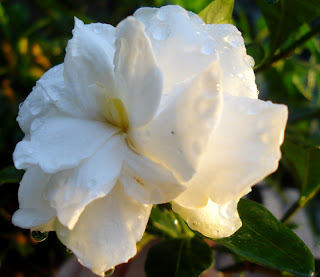As if alligators weren't enough, this sign recently went up in our subdivision:
If I’m honest, from now until about November, I am pretty unhappy about living in Florida. Summers here are brutal—heat in the 90s with matching humidity, giving us heat index ratings in the 100s for days on end. And there are no cool mornings or evenings to offer a break—mornings and evenings may be a teeny bit cooler, yes, but just as humid which is what bothers me the most. It’s like having a hot, wet towel thrown over your head.
Anyway this post is not supposed to be a long complaint about the weather (see: title). It’s supposed to be about what I love about Florida—things I will concentrate on when the humidity makes me wish I never set foot in this state. Here are a few:
Florida skies. Whether they’re bright blue or swirled with soft-serve clouds, Florida skies are breathtaking. I moved here from Southern California, where the sky was usually a flat gray or even white with few clouds to liven up the expanse. I know there must have been plenty of blue-sky days, but they were nothing to the daily show Florida’s skies put on.
Birds. I never paid much attention to birds until I moved to Florida—but having Sandhill Cranes in your back yard will get your attention. In addition to the cranes, which raise babies all over town every year, I’ve seen pileated woodpeckers, roseate spoonbills, and great blue herons in our subdivision, along with countless other species. We have a long, rectangular retention pond not far from our house, and I keep meaning to walk down there with my camera and bird book and see how many birds I can identify. We’ve had Carolina wrens build a nest and raise a batch of babies in our garage and another at the base of a potted bougainvillea. When I walk the dog at night, sometimes I hear an owl.
 |
| Sandhill cranes (not my yard, though!) |
Thunder—if I’m safely inside*. I love the rumbly, grumbly sound of rolling thunder from a summer storm. Our wimpy California storms had nothing like Florida thunder, which can sometimes shake the windows. Few things are cosier than lying in bed listening to thunder and the patter of rain drops. *Unfortunately, I’m terrified of lightning!
I know there are more things I could list that I love about Florida if I thought about it harder. Ask me again in February, and I’ll come up with a whole new list!
What are some things you love about where you live?
 |
| Photo: USFWS Endangered Species |
Manatees are gentle, passive and slow moving, but can be surprisingly nimble, able to swim upside down, do barrel rolls or stand on their heads or tails. They have no natural enemies, but unfortunately some are injured or killed each year by boats and other human-related causes. Manatees are migratory, and Tampa Bay is home to approximately 200 of them in winter, and around 100 in summer. (There are approximately 3800 manatees total in the U.S., according to savethemanatee.org.) West Indian manatees are protected in the United States under federal law by the Marine Mammal Protection Act of 1972 and the Endangered Species Act of 1973, as well as the Florida Manatee Sanctuary Act of 1978.
Manatees reproduce slowly, only reaching sexual maturity at age five. One calf is born every two to three years (twins are rare), after a 13-month gestation. Calves stay with their mothers during the first two years of life, so sometimes one mother will be accompanied by both her older and younger calves at the same time.
As strange as it may seem if you’ve gotten a good look at one, legend has it that sailors mistook manatees for the sirens of Greek myth, those temptresses who lured sailors to their deaths on reefs and rocks. This is reflected in the manatee's order name, Sirenia.
The manatee’s closest relatives are the elephant, aardvark and hyrax. The West Indian manatee is also related to the West African manatee, the Amazonian manatee and the dugong.















